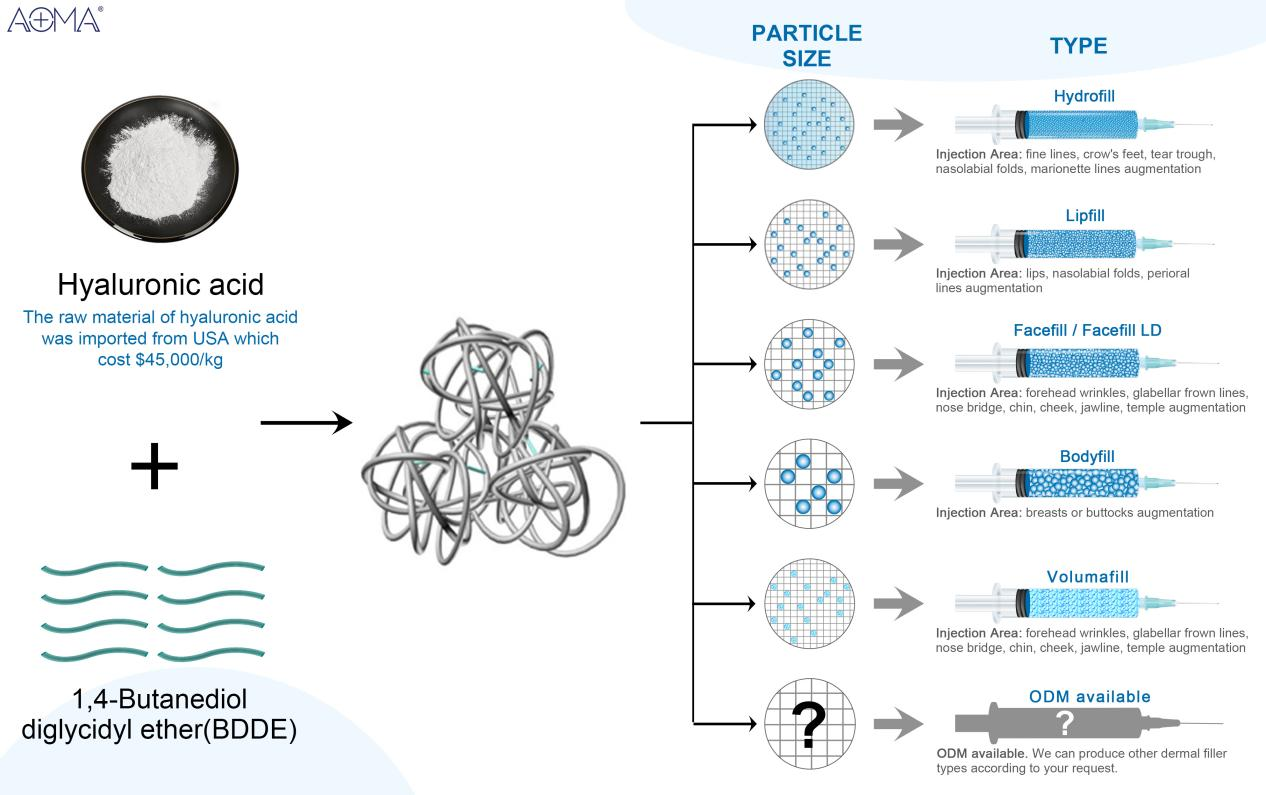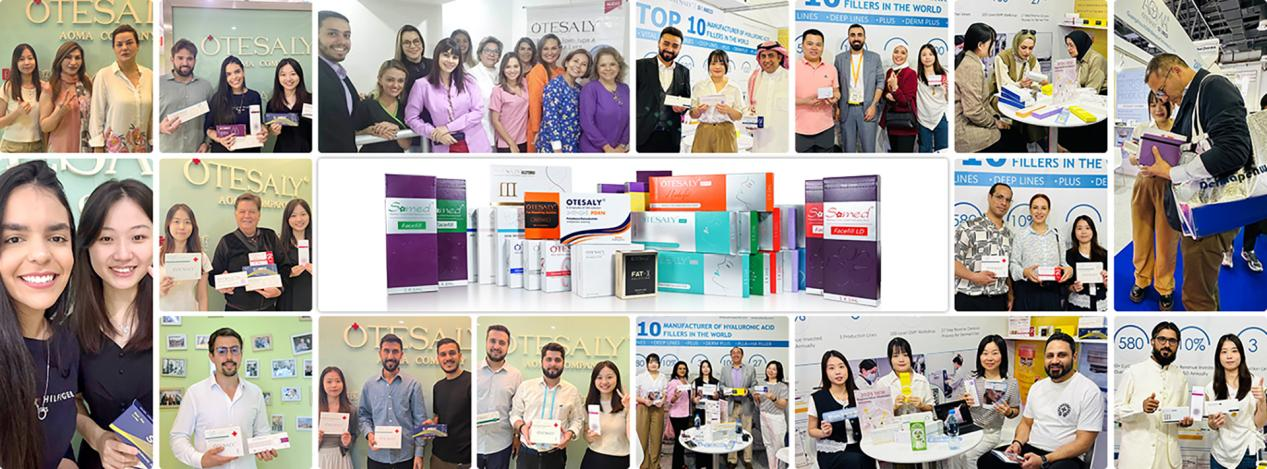In the field of medical aesthetics, the success of hyaluronic acid filler treatment goes far beyond the precise injection techniques of doctors. This article aims to be your authoritative resource library. We will delve into how to scientifically select the type of hyaluronic acid based on requirements, elaborate on the post-injection care guidelines that meet the highest medical standards, and answer the core questions about hyaluronic acid filler longevity.
Product Selection Principles: Decision-making framework based on rheological properties
Preoperative consultation is the cornerstone of success. The most crucial aspect is to select the filler product that best matches the client's aesthetic goals for them. First of all, it is necessary to understand how its physical properties correspond to different clinical needs. This is part of the safety standards dermal fillers to ensure that the product is used for the correct indications.
The selection of hyaluronic acid fillers should follow the principles of materials science. The rheological properties of a product directly determine its clinical applicability, including three core parameters: hardness, cohesion and elasticity.
At Guangzhou AOMA Biotechnology Co., LTD., we offer a diversified product matrix that has been strictly certified, aiming to meet the precise demands of the global medical aesthetics market.
High-hardness products are suitable for bony structure remodeling, such as AOMA Volumafill, which can effectively target chin filling and nose bridge shaping.
This type of product needs to have strong support to maintain contour stability.
Medium-hardness products are suitable for soft tissue filling, such as AOMA Facefill LD, which can correct nasolabial folds and cheek shaping. Its characteristics need to balance shaping force and tissue compatibility.
Low-hardness products are suitable for shallow filling, such as AOMA Lipfill, which can be used for lip augmentation and fine line correction. Such products should have excellent flexibility and ductility.

Preoperative preparation and expectation management
After determining the appropriate product, the final preoperative preparations need to be completed. Using the real before and after gallery hyaluronic acid fillers for intuitive illustration is the most effective way to manage customer expectations.
Scientific Postoperative Care Procedures
The moment the injection is completed, the quality of the post-injection care HA filler you provide directly determines the customer's satisfaction and the durability of the effect.
Intermittent cold compresses should be applied within 4 hours after the operation. Each cold compress should not exceed 10 minutes, with an interval of 20 minutes. Avoid direct pressure on the injection area.
High-temperature environments must be strictly avoided for 48 hours after the operation. Sauna, hot baths and intense exercise can cause blood vessels to dilate, which may increase the metabolic rate of fillers by approximately 30%. It is also recommended to maintain an upright sleeping position to avoid pressure on the face.
A regular assessment mechanism should be established within two weeks after the operation. It is recommended to conduct follow-ups on the 7th and 14th days, and record the stability of the effect through standardized photography. Clinical data show that standardized follow-up can increase customer satisfaction to 92%.
Management of effect duration: Anticipatory control based on clinical data
The duration of hyaluronic acid fillers is influenced by multiple factors. The metabolic rate of the product is positively correlated with the activity intensity of the injection site. The average retention time in the nasolabial fold area is 25-30% shorter than that in the zygomatic area.
The "6-month effect" refers to the period during which the filler maintains the best visual effect. At this stage, the filler maintains approximately 85% of its initial volume, and the tissue fusion reaches its peak. "12-month persistence" refers to the time point during which high-quality products can still maintain the basic contour support at the end of metabolism.
Clinical studies have shown that the use of high-cohesion products combined with standardized care can maintain the nasal shaping effect for 18 to 24 months. Lip filling, due to frequent muscle activity, usually lasts for 6 to 9 months.
Conclusion
Join hands with Guangzhou AOMA Biological Technology Co., Ltd to transform professional knowledge and high-quality products into outstanding clinical outcomes
A detailed care manual is an extension of your professional service, and when professional post-injection care HA filler is combined with scientifically designed HA filler products from AOMA World, you will provide customers with a complete solution that is long-lasting and safe.
We invite you to gain an in-depth understanding of how the AOMA product matrix, with its commitment to the highest safety standards dermal fillers and its pursuit of outstanding hyaluronic acid filler longevity, can be a powerful driving force for your business growth.

FAQ
Q1: How to ensure the naturalness of the effect after injection?
A: The naturalness of the effect depends on the precise match between the product features and the injection site. For dynamic areas such as the lips, it is recommended to choose products with a elastic modulus lower than 200Pa, as their deformation capacity is closer to that of natural soft tissues. For structural parts such as the nose, products with a G' value exceeding 500Pa should be selected to ensure contour stability. Clinical data shows that choosing products based on this standard can increase patient satisfaction to 94%.
Q2: How long does swelling last after injection and what are the corresponding measures?
A: The degree of swelling is directly related to the characteristics of the product formula. Due to the uniform molecular distribution, the average swelling time of the single-phase filler was 2.3±0.5 days, which was significantly lower than that of the two-phase product, which was 3.7±0.8 days. It is recommended to choose a low osmotic pressure formula, which can effectively reduce tissue edema. Immediately after the operation, use a porous ice compress device for 10 minutes each time with a 2-hour interval for 6 hours, which can reduce the degree of swelling by approximately 45%.
Q3: What are the key factors that affect the duration of the effect?
The main influencing factors include product characteristics, injection sites and individual metabolic differences. The retention time of highly cross-linked products on the nose can reach 18 to 24 months, while on the lips it is usually 6 to 9 months. Clinical studies have shown that the duration of the effect of booster treatment 6 to 9 months after the first injection is approximately 40% longer than that of re-injection after complete metabolism. Combined with non-invasive phototherapy, it can stimulate collagen regeneration and further prolong the overall effect.
Q4: How to deal with postoperative asymmetry?
A: Slight asymmetry (≤5%) is a common phenomenon and usually improves on its own within two weeks as the swelling subsides. If there is still obvious asymmetry after 14 days, hyaluronidase can be used for fine adjustment. It is recommended to retain 10% to 15% of the filler dosage for the first injection to facilitate precise fine-tuning within 7 to 14 days. Statistics show that only 3.2% of the cases require enzymatic hydrolysis treatment.
Q5: How to maximize the duration of the effect?
A: It is recommended to adopt a comprehensive solution: Firstly, choose products with high cohesion, whose anti-deformation ability is enhanced by approximately 50%; Secondly, strictly following the postoperative care norms and avoiding high-temperature environments (> 40℃) can reduce the metabolic rate by approximately 30%. Finally, it is recommended to establish a regular maintenance plan and receive supplementary injections at the initial stage of effect decline (usually 6 to 9 months). Clinical data show that this plan can extend the overall effect duration by 60% to 80%.
Q6: When should re-treatment be considered?
Based on 5,000 clinical observations, it is recommended to conduct re-treatment when the following indicators occur: A 15%-20% reduction in tissue volume, a decline of one grade in contour clarity, or a drop in patient self-assessment satisfaction to below 80%. The regular maintenance cycle is as follows: 6 to 8 months for the lips, 9 to 12 months for the nasolabial fold, and 12 to 18 months for the bony structure. Preventive maintenance saves approximately 35% of the dosage of the formulation compared to reconstitution after complete absorption.





















